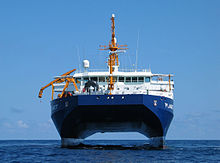



Asmall waterplane area twin hull, better known by the acronym SWATH, is a catamaran design that minimizes hull cross section area at the sea's surface. Minimizing the ship's volume near the surface area of the sea, where wave energy is located, minimizes a vessel's response to sea state, even in high seas and at high speeds. The bulk of the displacement necessary to keep the ship afloat is located beneath the waves, where it is less affected by wave action. Wave excitation drops exponentially as depth increases, so wave action normally does not affect a submerged submarine at all. Placing the majority of a ship's displacement under the waves is similar in concept to creating a ship that rides atop twin submarines.
The twin-hull design provides a stable platform and large, broad decks. Compared with conventional catamarans, SWATH vessels have more surface drag, but less wave drag. They are less susceptible to wave motion but more sensitive to payload, which affects draught. Additionally, SWATH vessels cannot operate in planing or semi-planing modes and thus gain no drag reduction when operating at speeds normally associated with such modes.[1] They require a complex control system, have a deeper draft, and have higher maintenance requirements. The design of SWATH vessels is also considerably more complex due to the structural complexities inherent to the design.[2]
The SWATH form was invented by Canadian Frederick G. Creed, who presented his idea in 1938, and was later awarded a British patent for it in 1946. The first full-scale SWATH vessel to be built and put into service was MV Duplus,[3] a diving support vessel built in the Netherlands in 1968. In the 1970s, several units were built in different countries (including the RV Kaimalino by the US Navy,[4] and an 80 ft (24 m) ferry in Japan). Since the 1980s, oceanographic research vessels, pilot tenders, yachts and other craft are more routinely being built with the SWATH hull type.[5]

